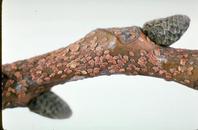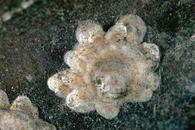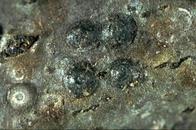
Frosted scale
Identification tip: Frosted scales overwinter as brownish,
flat nymphs.
|

Walnut scale
Identification
tip: After the first molt, males begin to develop an
elongated covering, often clustered in daisy-shaped groups
beneath the margin of the female’s round cover.
|

European fruit lecanium
Identification tip: Look for legless, immobile, yellow
insects on twigs. Older nymphs may have brown markings
and a distinct center ridge.
|

San
Jose scale (nymphs)
Identification tip: The four
round, dark scales in the center are the black cap stage,
the most common overwintering form. The earlier white cap
stage is to left. |